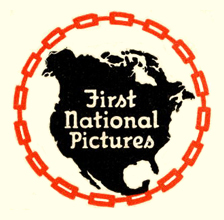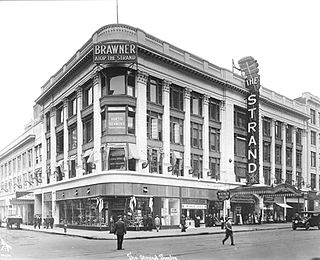
First National Pictures was an American motion picture production and distribution company. It was founded in 1917 as First National Exhibitors' Circuit, Inc., an association of independent theatre owners in the United States, and became the country's largest theater chain. Expanding from exhibiting movies to distributing them, the company reincorporated in 1919 as Associated First National Theatres, Inc. and Associated First National Pictures, Inc.

A movie theater, cinema, or cinema hall, also known as a movie house, picture house, picture theater or simply theater, is a business that contains auditoria for viewing films for public entertainment. Most are commercial operations catering to the general public, who attend by purchasing tickets.

Universal City Studios LLC, doing business as Universal Pictures, is an American film production and distribution company owned by NBCUniversal, a division of Comcast.

Cinerama is a widescreen process that originally projected images simultaneously from three synchronized 35mm projectors onto a huge, deeply curved screen, subtending 146-degrees of arc. The trademarked process was marketed by the Cinerama corporation. It was the first of several novel processes introduced during the 1950s when the movie industry was reacting to competition from television. Cinerama was presented to the public as a theatrical event, with reserved seating and printed programs, and audience members often dressed in their best attire for the evening.

Major film studios are production and distribution companies that release a substantial number of films annually and consistently command a significant share of box office revenue in a given market. In the American and international markets, the major film studios, often known simply as the majors or the Big Five studios, are commonly regarded as the five diversified media conglomerates whose various film production and distribution subsidiaries collectively command approximately 80 to 85% of U.S. box office revenue. The term may also be applied more specifically to the primary motion picture business subsidiary of each respective conglomerate.

The Cinerama Dome is a movie theater located at 6360 Sunset Boulevard in Hollywood, California. Designed to exhibit widescreen Cinerama films, it opened November 7, 1963. The original developer was William R. Forman, founder of Pacific Theatres. The Cinerama Dome continued as a leading first-run theater, most recently as part of the ArcLight Hollywood complex, until it closed temporarily in March 2020 due to the COVID-19 pandemic in California. The ArcLight chain closed permanently in April 2021, with the theater never having reopened. In June 2022, it was announced that there were plans to reopen it and the former ArcLight Hollywood under a new name, Cinerama Hollywood.

TriStar Pictures, Inc. is an American film studio and production company that is a member of the Sony Pictures Motion Picture Group, part of the multinational conglomerate Sony. It is a corporate sibling of Sony studio Columbia Pictures.

The Cannon Group, Inc. was an American group of companies, including Cannon Films, which produced films from 1967 to 1994. The extensive group also owned, amongst others, a large international cinema chain and a video film company that invested heavily in the video market, buying the international video rights to several classic film libraries. Some of their best known films include Joe (1970), Runaway Train (1985) and Street Smart (1987), all of which were Oscar-nominated.

Todd-AO is an American post-production company founded in 1953 by Mike Todd and Robert Naify, providing sound-related services to the motion picture and television industries. For more than five decades, it was the worldwide leader in theater sound. The company retains one facility, in the Los Angeles area.

The Biograph Company, also known as the American Mutoscope and Biograph Company, was a motion picture company founded in 1895 and active until 1916. It was the first company in the United States devoted entirely to film production and exhibition, and for two decades was one of the most prolific, releasing over 3000 short films and 12 feature films. During the height of silent film as a medium, Biograph was the most prominent U.S. film studio and one of the most respected and influential studios worldwide, only rivaled by Germany's UFA, Sweden's Svensk Filmindustri and France's Pathé. The company was home to pioneering director D. W. Griffith and such actors as Mary Pickford, Lillian Gish, and Lionel Barrymore.
United States v. Paramount Pictures, Inc., 334 U.S. 131 (1948), was a landmark United States Supreme Court antitrust case that decided the fate of film studios owning their own theatres and holding exclusivity rights on which theatres would show their movies. It would also change the way Hollywood movies were produced, distributed, and exhibited. It also opened the door for more foreign and independent films to be shown in U.S. theaters. The Supreme Court affirmed the United States District Court for the Southern District of New York's ruling that the existing distribution scheme was in violation of United States antitrust law, which prohibits certain exclusive dealing arrangements.

Walt Disney Studios Motion Pictures is an American film distributor within the Disney Entertainment division of the Walt Disney Company. It handles theatrical and occasional digital distribution, marketing and promotion for films produced and released by the Walt Disney Studios, including Walt Disney Pictures, Walt Disney Animation Studios, Pixar, Marvel Studios, Lucasfilm, and 20th Century Studios; the Searchlight Pictures label operates its own autonomous theatrical distribution and marketing unit.

Ultra Panavision 70 and MGM Camera 65 were, from 1957 to 1966, the marketing brands that identified motion pictures photographed with Panavision's anamorphic movie camera lenses on 65 mm film. Ultra Panavision 70 and MGM Camera 65 were shot at 24 frames per second (fps) using anamorphic camera lenses. Ultra Panavision 70 and MGM Camera 65's anamorphic lenses compressed the image 1.25 times, yielding an extremely wide aspect ratio of 2.76:1.
National General Corporation (NGC) was a theater chain holding company, film distribution and production company and was considered one of the "instant majors". It was in operation from 1951 to 1974.

The Strand Theatre was an early movie palace located at 1579 Broadway, at the northwest corner of 47th Street and Broadway in Times Square, New York City. Opened in 1914, the theater was later known as the Mark Strand Theatre, the Warner Theatre, and the Cinerama Theatre. It closed as the RKO Warner Twin Theatre, and was demolished in 1987.

A film – also called a movie, motion picture, moving picture, picture, photoplay or (slang) flick – is a work of visual art that simulates experiences and otherwise communicates ideas, stories, perceptions, feelings, beauty, or atmosphere through the use of moving images. These images are generally accompanied by sound and, more rarely, other sensory stimulations. The word "cinema", short for cinematography, is often used to refer to filmmaking and the film industry, and the art form that is the result of it.

Cinema Center Films (CCF) was the theatrical film production company of the CBS Television Network from 1967 to 1972. Its films were distributed by National General Pictures. The production unit was located at CBS Studio Center in the Studio City district of Los Angeles in the San Fernando Valley, and produced 30 films.
Swank Motion Pictures, Inc. is an international, non-theatrical, film distributor and licensor. Founded in 1937, it is privately owned and operated by the Swank family. It is one of the world's largest non-theatrical distributors of motion pictures for public performance. Based in Sunset Hills, a suburb of St. Louis, Swank also maintains a sales office in Paris.













